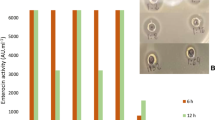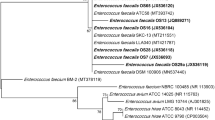Abstract
Antibiotic susceptibility or resistance, urease activity, detection of the structural genes for bacteriocin production, bacteriocin activity as well as sensitivity of the isolates to enterocins (Ent) A and M were determined in 23 isolates of new speciesEnterococcus haemoperoxidus andE. moraviensis. The majority of the strains were antibiotic sensitive and exhibited low urease activity (<10 nkat/mL). The most frequently detected genes for Ent wereentA andentP. However, only the strain 466 ofE. haemoperoxidus produced an antibacterial substance with inhibitory activity against 21 G+ indicators. It was partially purified reaching an activity of up to 12 800 AU/mL. This bacteriocin active strain also possessed the genes for EntA and EntP. The other strains did not inhibit the indicator strains. The substance produced by the 466 strain was active even after a 5-months storage at +4 and −20°C. This substance has proteolytic and hydrophilic character, pH optimum of bacteriocin production by this strain being between 4 and 7. WhileE. moraviensis strains showed sensitivity to EntA (produced byE. faecium EK13) and to EntM (produced byE. faecium AL41),E. haemoperoxidus strains were sensitive to EntA (except strain 382) but less sensitive to the treatment by EntM.
Similar content being viewed by others
Abbreviations
- E.h. :
-
E. haemoperoxidus
- Ent:
-
enterocin(s)
- Amp:
-
ampicillin
- Kan:
-
kanamycin
- Tet:
-
tetracycline
- E.m. :
-
E. moraviensis
- PPS:
-
partially purified substance
- Cap:
-
chloramphenicol
- Nov:
-
novobiocin
- Van:
-
vancomycin
- Ery:
-
erythromycin
- Rif:
-
rifampicin
References
Aymerich T., Holo H., Havarstein L.S., Hugas M., Garriga M., Nes I.F.: Biochemical and genetic characterization of enterocin A fromEnterococcus faecium, a new antilisterial bacteriocin in the pediocin family of bacteriocins.Appl.Environ.Microbiol. 62, 1676–1682 (1996).
Becquet P.: EU assessment of enterococci as feed additives.Internat.J.Food Microbiol. 88, 247–254 (2003).
Casaus P., Nilsen T., Cintas L.M., Nes I.F., Hernandez P.E., Holo H.: Enterocin B, a new bacteriocin fromEnterococcus faecium T136 which can act synergistically with enterocin A.Microbiology 143, 2287–2294 (1997).
Cintas L.M., Casaus P., Havarstain L.V., Hernandez P.E., Nes I.F.: Biochemical and genetic characterization of enterocin P, a novel sec-dependent bacteriocin fromEnterococcus faecium P13 with abroad antimicrobial spectrum.Appl.Environ.Microbiol. 63, 4321–4330 (1997).
Cintas L.M., Casaus P., Holo H., Hernandez P.E., Nes I.F., Havarstain L.S.: Enterocins L50A and L50B, two novel bacteriocins fromEnterococcus faecium L50 are related to staphylococcal haemolysins.J.Bacteriol. 180, 1988–1994 (1998).
Cook A.R.: Urease activity in the rumen of sheep and the isolation of ureolytic bacteria.J.Gen.Microbiol. 92, 32–48 (1976).
Cuozzo S., Calvez S., Prévost H., Drider D.: Improvement of enterocin P purification process.Folia Microbiol. 51, 401–405 (2006).
Daněk P., Svozil B., Kumprecht I., Přikryl J., Koželuhová K.: The influence of application of the microbioticStreptococcus faecium M74 on the intestinal microflora in lambs until weaning. (In Czech)Czech J.Anim.Sci. 30, 157–164 (1985).
De Vuyst L., Callewaert R., Pot B.: Characterization and antagonistic activity ofLactobacillus amylovorus DCE471 and large scale isolation of its bacteriocin amylovorin L471.Syst.Appl.Microbiol. 19, 9–20 (1996).
Devriese L.A., Ceussens K., Haesebrouck F.: Characteristics ofEnterococcus caecorum strains from the intestines of different animal species.Lett.Appl.Microbiol. 12, 137–139 (1991).
Drahovská H., Slobodníková L., Kocínová D., Seman M., Končeková R., Trupl J., Turňa J.: Antibiotic resistance and virulence factors among clinical and food enterococci isolated in Slovakia.Folia Microbiol. 49, 763–768 (2004).
Facklam R., Sahm R., Teixiera L.M.:Enterococcus, pp. 297–305 inManual of Clinical Microbiology, 7th ed. (P.R. Murray, E.J. Baron, M.A. Pfaller, F.C. Tenover, R.H. Yolken, Eds). American Society for Microbiology, Washington (DC) 1999.
Filipová M., Bujdáková H., Drahovská H., Lišková A., Hanzen J.: Occurrence of aminoglycoside-modifying-enzyme genesaac(6)—aph(2′), aph(3′), ant(4′) andant(6) in clinical isolates ofEnterococcus faecalis resistant to high-level of gentamicin and amikacin.Folia Microbiol. 51, 57–61 (2006).
Foulquié-Moreno M.R.: Microbiological and technological characterization of bacteriocin-producing enterococci.PhD Thesis, pp. 33–55. Vrije Universiteit Brussel (Belgium) 2002.
Foulquié-Moreno M.R., Leisner J.J., Tee L.K., Ley C., Radu S., Rusul G., Vancanneyt M., De Vuyst L.: Characterization of two bacteriocins produced by isolates ofEnterococcus faecium from Malaysian tempeh.J.Appl.Microbiol. 92, 147–157 (2002).
Franz C.M.P.A., Holzapfel W.H., Stiles M.E.: Enterococci at the crossroads of food safety?Internat.J.Food Microbiol. 47, 1–24 (1999a).
Franz C.M.P.A., Worobo R.W., Quadri L.E.N., Schillinger U., Holzapfel W.H., Vederas J.C., Stiles M.E.: Atypical genetic locus associated with constitutive production of enterocin B byEnterococcus faecium BFE 900.Appl.Environ.Microbiol. 65, 2170–2178 (1999b).
French P., Venuti E., Fraimow H.S.:In vitro activity of novobiocin against multiresistant strains ofEnterococcus faecium.Antimicrob.Agents Chemother. 37, 2736–2739 (1993).
Fuuersted K.: Evaluation of the combination effects of ampicillin or vancomycin combined with streptomycin, gentamicin, tobramycin or netilmicin against enterococci.APMIS 97, 23–26 (1989).
Girrafa G., Sisto F.: Susceptibility to vancomycin of enterococci from dairy products.Lett.Appl.Microbiol. 25, 335–338 (1997).
Hermann D.J., Gerding D.N.: Antimicrobial resistance among enterococci.Antimicrob.Agents Chemother. 35, 1–4 (1991).
Jurkovič D., Križková R., Dušinský R., Belicová A., Sojka M., Krajčovič J., Ebringer L.: Identification and characterization of enterococci from bryndza cheese.Lett.Appl.Microbiol. 42, 553–559 (2006).
Kuhn I., Iversen A., Burman L.G., Olsson-Liljequist B., Franklin A., Finn M., Aarestrup F., Seyfarth A.M., Blanch A.R.: Epidemiology and ecology of enterococci with special reference to antibiotic resistant strains, in animals, humans and the environment. Example of an ongoing project within the European research programme.Internat.J.Antimicrob.Agents 14, 337–342 (2000).
Lauková A.: Biochemical and physiological properties of enterococci isolated from the rumen of calves.Czech J.Anim.Sci. 10, 857–860 (1992).
Lauková A., Czikková S.: Inhibition effect of enterocin CCM4231 in the rumen fluid environment.Lett.Appl.Microbiol. 26, 215–218 (1998).
Lauková A., Juriš P.: Distribution and characterization ofEnterococcus species in municipal sewages.Microbios 89, 73–80 (1997).
Lauková A., Koniarová I.: Survey of urease activity in ruminal bacteria isolated from domestic and wild ruminants.Microbios 84, 7–11 (1995).
Lauková A., Kuncová M., Kmeť V.: Isolation of several conjugative plasmids of the rumen bacteriaEnterococcus faecium.Biológia (Bratislava) 45, 533–538 (1990).
Lauková A., Mareková M., Javorský P.: Detection and antimicrobial spectrum of a bacteriocin-like substance produced byEnterococcus faecium CCM 4231.Lett.Appl.Microbiol. 16, 257–260 (1993).
Lauková A., Czikková S., Vasilková Z., Juriš P., Mareková M.: Occurrence of bacteriocin production among environmental enterococci.Lett.Appl.Microbiol. 27, 178–182 (1998a).
Lauková A., Czikková S., Vasilková Z., Juriš P., Krupicer I.: Antimicrobial effect of enterocin CCM 4231 in the cattle slurry environment.Cytobios 94, 73–79 (1998b).
Lauková A., Czikková S., Laczková S., Turek P.: Use of enterocin CCM 4231 to controlListeria monocytogenes in experimentally contaminated dry fermented Hornád salami.Internat.J.Food Microbiol. 52, 115–119 (1999).
Lauková A., Turek P., Mareková M., Nagy J.: Use of ent M, new variant of ent P to controlListeria innocua in experimentally contaminated Gombasek sausage.Arch.Lebensmittelhyg. 54, 25–48 (2003).
Lauková A., Strompfová V., Skřivanová V., Volek Z., Jindřichová E., Marounek M.: Bacteriocin-producing strain ofEnterococcus faecium EK13 with probiotic character and its application in the digestive tract of rabbits.Biologia (Bratislava) 61, 779–782 (2006).
Marciňáková M., Simonová M., Lauková A.: Probiotic properties ofEnterococcus faecium EF9296 strain isolated from silage.Acta Vet.Brno 73, 513–519 (2004).
Marciňáková M., Simonová M., Strompfová V., Lauková A.: Occurrence of structural enterocin genes among silage enterococci.Bull.Vet.Inst.Puławy 49, 387–391 (2005).
Marciňáková M., Simonová M., Strompfová V., Lauková A.: Oral application ofEnterococcus faecium strain EE3 in healthy dogs.Folia Microbiol. 51, 239–242 (2006).
Mareková M., Lauková A., Skaugen M., Nes I.F.: Characterization ofEnterococcus faecium AL41 strain and its bacteriocin. Conf. Proc.Prospects of Probiotics in Prevention and Therapy of Diseases of Young, Stará Lesná (Slovakia) 2000.
Mareková M., Lauková A., De Vuyst L., Skaugen M., Nes I.F.: Partial characterization of bacteriocins produced by environmental strainEnterococcus faecium EK13.J.Appl.Microbiol. 94, 523–530 (2003).
Mego M., Májek J., Končeková R., Ebringer L., Čierniková S., Rauko P., Kováč M., Trupl J., Slezák P., Zajac V.: Intramucosal bacteria in colon cancer and their elimination by probiotic strainEnterococcus faecium M74 with organic selenium.Folia Microbiol. 50, 443–447 (2005).
NCCLS (National Committe for Clinical Laboratory Standards) Document M100-S11: Performance Standards for Antimicrobial Susceptibility Testing, 11th Informat. Suppl. NCCSL, Wayne (USA) 2001.
Nes I.F., Holo H.: Class II antimicrobial peptides from lactic acid bacteria.Biopolymers 55, 50–61 (2000).
Sabia C., De Niederhausern S., Messi P., Manicardi G., Bondi M.: Bacteriocin-producingEnterococcus casseliflavus Im 416K1, a natural antagonist for control ofListeria monocytogenes in Italian sausages (“cacciatore”).Internat.J.Food Microbiol. 87, 173–179 (2003).
Sarantinopoulos P., Leroy F., Leontopoulou E., Georlaki M.D., Kalantzopoulos G., Tsakalidou E., De Vuyst L.: Bacteriocin production byEnterococcus faecium FAIR-E198 in view of its application as adjunct in Greek Feta cheese making.Internat.J.Food Microbiol. 72, 125–136 (2002).
Simonová M., Lauková A., Štyriak I.: Enterococci from rabbits-potential feed additive.Czech J.Anim.Sci. 50, 416–421 (2005).
Strompfová V., Lauková A., Ouwehand A.C.: Lactobacilli and enterococci — potential probiotics for dogs.Folia Microbiol. 49, 203–207 (2004).
Strompfová V., Simonová M., Marciňáková M., Lauková A.: Distribution of enterocins among enterococci from Slovak, French and Italian fermented meat products, p. 47 inBook of Contributions of the 4th Conf. Structure and Stability of Biomacro-molecules SSB, Košice (Slovakia) 2005.
Švec P., Devriese L.A., Sedláček I., Baele M., Vancanneyt M., Haesebrouck F., Swings J.D., Doškař J.:Enterococcus haemoperoxidus sp.nov. andEnt. moraviensis sp.nov., isolated from water.Internat.J.Syst.Evol.Microbiol. 51, 1567–1574 (2001a).
Švec P., Sedláček I., Pantůček R., Devriese L.A., Doškař J.: Evaluation of ribotyping for characterization and identification ofEnterococcus haemoperoxidus andEnt. moraviensis strains.FEMS Microbiol.Lett. 203, 23–27 (2001b).
Toba T., Yoshioka E., Itoh T.: Lacticin, a bacteriocin produced byLactobacillus delbrueckii subsp.lactis.Lett.Appl.Microbiol. 12, 43–45 (1991).
Author information
Authors and Affiliations
Corresponding author
Additional information
This work was supported by the Slovak-Czech/Czech-Slovak bilateral project no. 187/164/22 byMinistry of Education of both republics; part of this work was also funded by the project VEGA 2/5139/27 ofSlovak Scientific Agency.
Rights and permissions
About this article
Cite this article
Lauková, A., Švec, P., Strompfová, V. et al. Properties of the strainsEnterococcus haemoperoxidus andE. moraviensis, new species among enterococci. Folia Microbiol 52, 273–279 (2007). https://doi.org/10.1007/BF02931309
Received:
Revised:
Issue Date:
DOI: https://doi.org/10.1007/BF02931309




